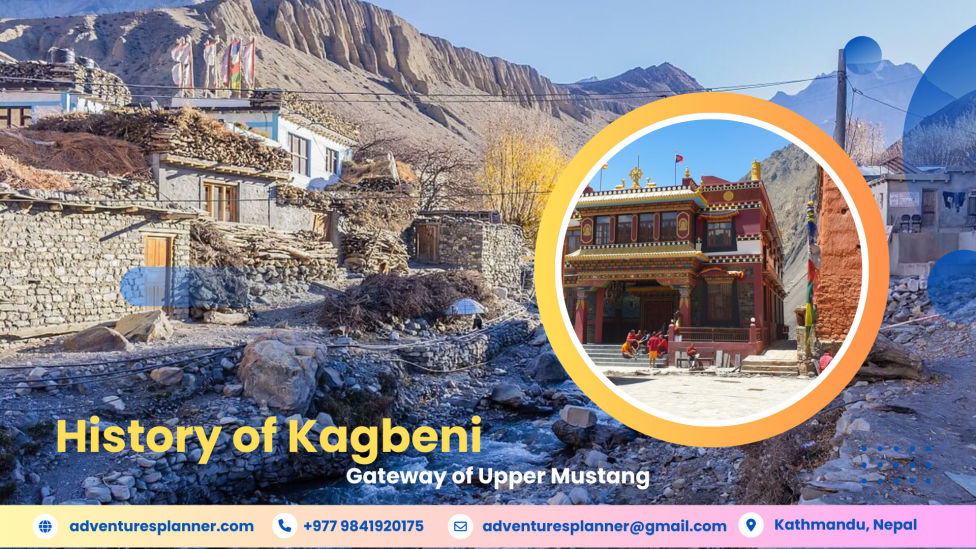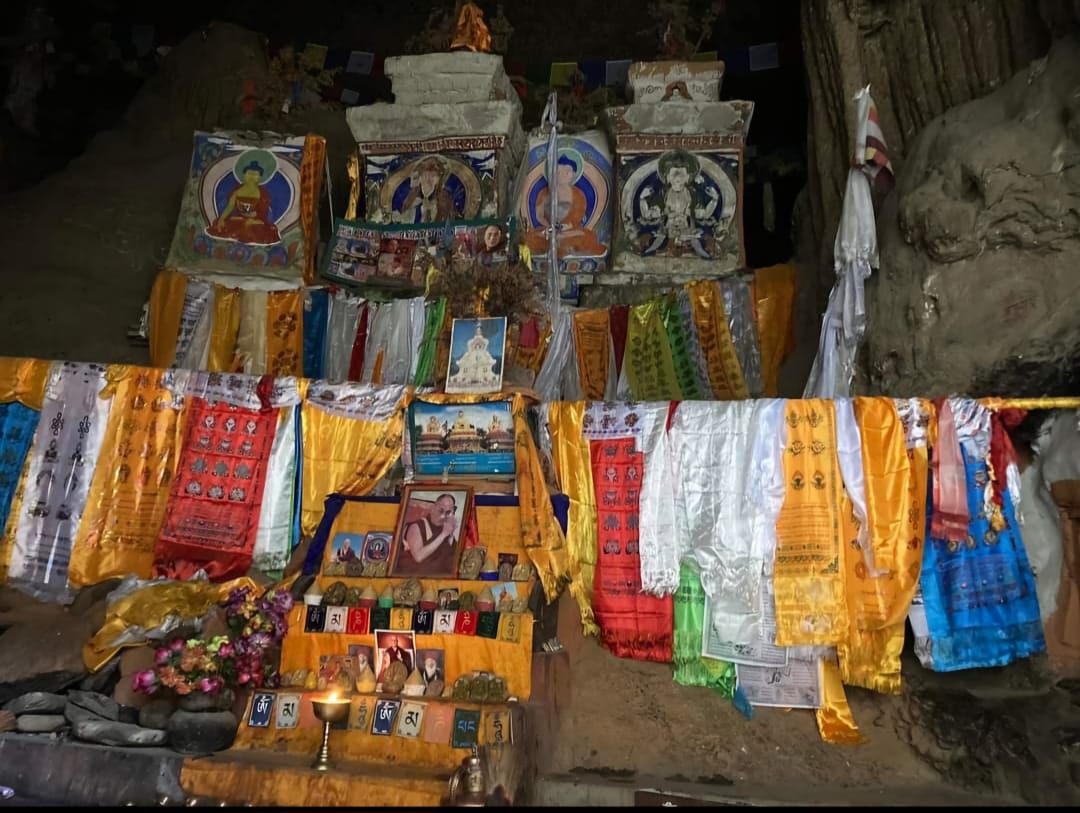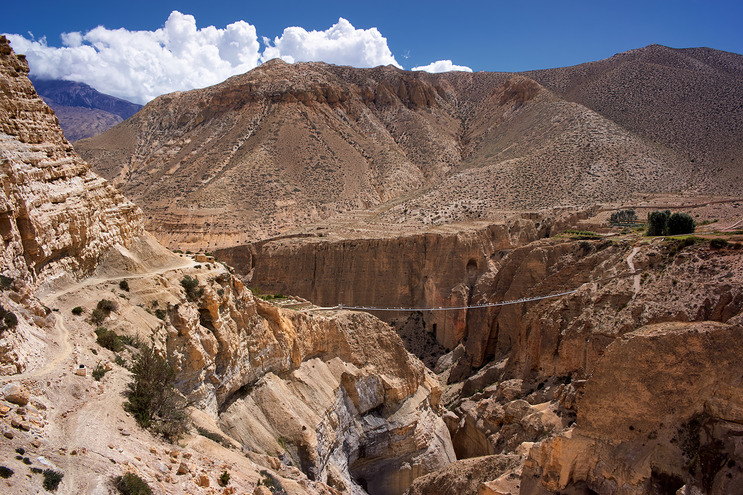Kagbeni is a picturesque village located in the Mustang region of Nepal. It lies at an altitude of about 2,800 meters (9,186 feet) and is a popular stop for trekkers on the Annapurna Circuit. Known for its stunning views of the Himalayas, including the Annapurna and Dhaulagiri ranges, Kagbeni has a unique charm, blending Tibetan culture and natural beauty.
The village is also historically significant, as it was a trade route between Nepal and Tibet. The architecture in Kagbeni is typically traditional Tibetan, with flat-roofed houses, monasteries, and narrow alleyways. One of its most notable landmarks is the Kagbeni Monastery, which has a rich history and offers a glimpse into the spiritual life of the area.
Kagbeni is also considered the gateway to Upper Mustang, an area that requires special permits for access due to its unique cultural and environmental heritage. The region is known for its dramatic landscapes, with a stark, desert-like terrain, and is often referred to as the "Forbidden Kingdom" due to its isolation from the rest of Nepal for centuries.
History of Kagbeni - Gateway of Upper Mustang Trek
Kagbeni, often referred to as the "Gateway to Upper Mustang," holds a rich historical significance due to its strategic location and cultural heritage. The village lies at the confluence of the Kali Gandaki River and the trail leading to Upper Mustang, an area that has remained a relatively isolated and culturally preserved region of Nepal for centuries. Below is a detailed history of Kagbeni in the context of its role as the gateway to Upper Mustang:
Ancient Roots and Geographic Importance of Kagbeni
Kagbeni’s history can be traced back to ancient times. The village has been a significant settlement in the Mustang Kingdom, which historically existed as an independent region before it became part of Nepal. It is located along the Kali Gandaki River, which has been a crucial trade route linking Nepal to Tibet for centuries.
The village's strategic location made it a key point along the ancient Tibetan trade route, which connected Tibet with Nepal and India. The river was the primary path for traders and pilgrims who traveled across the rugged terrain of the Himalayas, transporting goods such as salt, wool, and medicinal herbs between Tibet and the lowlands of Nepal.
Tibetan Influence and Buddhist Tradition
The history of Kagbeni is deeply influenced by Tibetan Buddhism. Tibetan-speaking people traditionally inhabited the region who followed Tibetan Buddhist customs and practices. Many of the monasteries, gompas (monastic communities), and stupas (Buddhist shrines) in the area are remnants of this heritage, with structures dating back hundreds of years.
Kagbeni, with its ancient Kagbeni Monastery, served as a cultural and spiritual center for local Tibetan Buddhist communities. The Kagbeni Monastery, established in the 14th century, holds significant spiritual value, and it is believed to house important religious relics and sacred Buddhist texts.
Trade and Cultural Exchange
From the 15th century onward, Kagbeni thrived as a key stop on the Tibetan trade route, facilitating cultural and commercial exchange between Nepal and Tibet. Goods like salt, wool, and pashmina were exchanged for grains, metal tools, and other commodities from the lowlands. This created a vibrant cultural melting pot where Tibetan customs and traditions merged with those of the Nepali people.
Kagbeni's location allowed it to play a crucial role in the political and economic ties between Nepal and Tibet. Even after the region became a part of Nepal in the mid-18th century, Kagbeni remained a culturally distinct area, retaining its Tibetan influence in language, architecture, and religion.
Upper Mustang and Isolation
During the 19th and early 20th centuries, Upper Mustang (and by extension, Kagbeni) remained relatively isolated from the rest of Nepal due to its geographical remoteness and political status. The Kingdom of Mustang, which included Kagbeni, maintained a semi-autonomous status for much of its history, with its own rulers, the Rana Dynasty of Mustang.
The isolation of Upper Mustang meant that the culture and way of life there remained largely unaffected by outside influences. This isolation also preserved the unique Tibetan culture in the region, especially in Kagbeni, which remained a bastion of Tibetan Buddhist tradition. Kagbeni thus became an important stop for pilgrims, traders, and travelers en route to Muktinath, a sacred pilgrimage site for Hindus and Buddhists alike.
Modern History of Kagbeni
In 1992, Nepal opened the region of Upper Mustang to tourism, though it remains a restricted area. The introduction of the Trekking Permit System in 1992 allowed a limited number of trekkers to visit Kagbeni and other parts of Mustang, thus opening the doors for international tourism while still maintaining the area's cultural heritage and preservation.
The construction of a road linking Jomsom to Kagbeni, and subsequently to Muktinath, improved access to the region, but it also brought some changes to the traditional lifestyle of the people. Despite these changes, Kagbeni still retains much of its ancient charm and remains a significant cultural and historical landmark.
Present-Day Kagbeni
Today, Kagbeni is both a historical treasure and a popular trekking destination. Visitors who trek to Kagbeni as part of the Annapurna Circuit or to visit Upper Mustang are introduced to its rich history, unique architecture, and preserved Tibetan culture. The Kagbeni Monastery remains an active religious site, while the traditional Tibetan houses, narrow alleys, and ancient stupas continue to reflect the village’s heritage.
The village also stands as a gateway to Upper Mustang, a region often referred to as the “Forbidden Kingdom” due to its historical isolation and the unique Tibetan Buddhist culture that has remained largely untouched by modernity. Many trekkers use Kagbeni as a base to venture further into Upper Mustang to explore the ancient monasteries, caves, and the stark landscapes of the region.
Summarize History of Kagbeni
Kagbeni's history is a testament to its strategic location along ancient trade routes, its Tibetan Buddhist influence, and its role as a gateway to the Upper Mustang region. From its days as a thriving trade hub to its current status as a cultural and trekking destination, Kagbeni offers a fascinating glimpse into the history and culture of the Tibetan-influenced Mustang region.
Major Highlights of Kagbeni
The major highlights of Kagbeni, a charming village in the Mustang region of Nepal, include:
Kagbeni Monastery:
- One of the most significant landmarks in the village, the Kagbeni Monastery (also known as the Kagbeni Gompa) offers a deep insight into Tibetan Buddhism. The monastery, with its ancient murals and sacred artifacts, is a peaceful spiritual center that attracts pilgrims and trekkers alike.
Tibetan Architecture:
- Kagbeni’s traditional Tibetan-style houses, narrow alleyways, and the iconic flat-roofed buildings are a major highlight. The village’s architecture is one of the key elements that help preserve its unique cultural heritage, making it feel like stepping into a different time.
Gateway to Upper Mustang:
- Kagbeni is the gateway to Upper Mustang, one of Nepal’s most remote and restricted regions. Trekkers must obtain special permits to explore this area, which is often called the "Forbidden Kingdom." This makes Kagbeni an essential stop for those trekking to Upper Mustang to witness its unique culture, monasteries, and landscapes.
Scenic Views of the Himalayas:
- Kagbeni offers spectacular panoramic views of several towering peaks, including Annapurna, Dhaulagiri, and Nilgiri. These views, especially during sunrise and sunset, are truly mesmerizing and make the village a prime location for photography and nature enthusiasts.
The Kali Gandaki River:
- The village is located near the Kali Gandaki River, which is one of the deepest gorges in the world. The river adds to the dramatic landscape of the region, and the surrounding cliffs and canyons create a stark contrast with the snow-capped peaks in the distance.
Cultural Experience:
- Kagbeni is a vibrant example of Tibetan culture. The village is home to local residents who still follow traditional Tibetan ways of life. Visitors can experience local customs, explore ancient Buddhist shrines, and learn about the village’s long history as a trade hub between Nepal and Tibet.
Historical Significance:
- Kagbeni has a rich history tied to the ancient trade route that connected Nepal to Tibet. The village has long been an important crossroads for traders and pilgrims, and remnants of this history can still be felt throughout the village.
Photography Opportunities:
- The unique landscapes of Kagbeni — including its Tibetan-style buildings, barren desert-like surroundings, and snow-capped mountains — provide endless opportunities for stunning photographs. The play of light and shadow in the early morning and late afternoon creates a magical atmosphere for photographers.
Kagbeni Village Walks:
- Walking around Kagbeni is an experience in itself. The narrow alleys, the sound of prayer flags fluttering in the wind, and the rustic ambiance make for a peaceful exploration of the village. It’s a great place to witness the lifestyle of the local people.
These highlights make Kagbeni not only a beautiful destination but also a cultural and spiritual hub that offers a unique experience for visitors exploring Nepal's Mustang region.
Best time to Visit Kagbeni
The best time to visit Kagbeni depends on your preferences for weather, trekking conditions, and the overall experience you're seeking. However, generally speaking, the best time to visit Kagbeni is during the spring (March to May) and autumn (September to November) months. Here's why:
1. Spring (March to May):
- Weather: The weather is generally mild, with daytime temperatures ranging from 10°C to 20°C (50°F to 68°F) and cooler nights. The skies are usually clear, providing great visibility for mountain views.
- Flora: The spring season brings blooming flowers, especially rhododendrons, which enhance the landscape and make the surroundings more picturesque.
- Ideal for Trekking: Spring is a perfect time for trekking because of the moderate weather and stable trail conditions, making it comfortable to hike through the region. The landscape is also lush and green.
2. Autumn (September to November):
- Weather: This is considered the peak trekking season in Nepal. The weather is crisp and clear with mild temperatures. Daytime temperatures usually range from 15°C to 25°C (59°F to 77°F), and the nights are cooler.
- Clear Skies: Autumn offers some of the clearest skies of the year, making it ideal for trekking and photography, as you'll get uninterrupted views of the Himalayan peaks surrounding Kagbeni.
- Festivals: If you're interested in local culture, visiting during the autumn months might allow you to experience traditional festivals like Tihar and Dashain, adding a cultural dimension to your trip.
3. Winter (December to February):
- Cold Temperatures: Winters in Kagbeni can be very cold, with temperatures often dropping below freezing at night and daytime temperatures hovering around 5°C to 10°C (41°F to 50°F).
- Snow: While the landscape becomes beautiful with snow, trekking conditions can be harsher, and some paths may be more difficult or even closed due to snow. However, if you’re prepared for the cold and want a quieter, off-the-beaten-path experience, winter can be an option.
- Low Crowds: The winter months are less crowded, offering a more peaceful and serene experience.
4. Summer/Monsoon (June to August):
- Heavy Rainfall: The monsoon season brings heavy rainfall to the region, especially in lower-altitude areas. While Kagbeni itself is less affected by the monsoon compared to other parts of Nepal (due to its semi-desert climate), the trails leading to it may be slippery or muddy.
- Limited Visibility: The heavy clouds and rain can obstruct mountain views, and trekking conditions can be challenging due to wet conditions.
- Fewer Tourists: If you prefer solitude and are willing to deal with the rain, visiting during the monsoon might provide a quieter experience.
Which time is Best to visit Kagbeni?
- Best Time: Spring (March to May) and Autumn (September to November) are the most favorable times to visit Kagbeni for comfortable trekking conditions, clear skies, and pleasant weather.
- Avoid Monsoon: If possible, avoid the monsoon season (June to August) for trekking, as trails may be challenging due to rain.
- Winter: Winter (December to February) is for those who prefer a quieter, colder experience with possible snow and lower trekking traffic.
Never Miss These Things While Travelling to Kagbeni
When traveling to Kagbeni, there are several things you shouldn’t miss out on to make your trip truly unforgettable. Here’s a list of experiences (Never Miss These Things While Travelling to Kagbeni), places, and activities to ensure you make the most of your visit:
1. Kagbeni Monastery (Kagbeni Gompa)
- What to Do: This ancient monastery is a must-visit. It offers a deep spiritual experience and a glimpse into the Tibetan Buddhist way of life. Don't miss out on the opportunity to explore its murals, prayer wheels, and serene atmosphere.
- Tip: If you're interested, you can interact with the monks and learn about their daily rituals and practices.
- What to Do: Kagbeni is the gateway to Upper Mustang, a culturally rich and remote region. If you have the necessary permits, take a trek to explore the "Forbidden Kingdom." It’s an extraordinary place with ancient monasteries, caves, and stunning landscapes.
- Tip: You need a special permit to enter Upper Mustang, so make sure to arrange this beforehand.
3. Exploring the Traditional Tibetan Architecture
- What to Do: Wander through Kagbeni's narrow streets and alleys, where you can see the unique Tibetan-style architecture, including flat-roofed houses, prayer flags, and Buddhist stupas. The town feels like a living museum of Tibetan culture.
- Tip: Take time to appreciate the details—look for intricate woodwork and stone carvings, which are significant in Tibetan architecture.
4. Stunning Views of the Himalayas
- What to Do: Don’t miss the panoramic views of the Annapurna, Dhaulagiri, and Nilgiri mountain ranges. Whether you're trekking or just relaxing in the village, these views are a highlight.
- Tip: Early morning or late afternoon provide the best light for photography, with dramatic lighting on the mountains.
5. Kali Gandaki Gorge
- What to Do: Kagbeni lies near the Kali Gandaki River, one of the deepest gorges in the world. Walk along the river or take a hike through the surrounding cliffs for dramatic landscapes.
- Tip: The river gorge is a great spot for some quiet reflection or photography. You can also explore small caves and rock formations in the area.
6. Cultural Interaction with Locals
- What to Do: Take the time to interact with the local people of Kagbeni. The village is home to people of Tibetan descent who maintain traditional lifestyles. Chatting with them gives you a deeper understanding of the culture.
- Tip: Be respectful of their customs, and if you can, learn a few words in Tibetan. Locals appreciate the effort.
7. Photography Opportunities
- What to Do: The combination of mountain landscapes, traditional architecture, and vibrant culture makes Kagbeni a photographer’s dream. From the village itself to the surrounding nature, there are countless opportunities for stunning photos.
- Tip: Bring extra memory cards and batteries, as you’ll likely take more pictures than you expect!
- What to Do: From Kagbeni, you can embark on a trek to Muktinath, one of the holiest sites in Nepal, which attracts both Buddhists and Hindus. The trek from Kagbeni to Muktinath is a rewarding and spiritual journey.
- Tip: Muktinath is known for its sacred temple, and the "eternal flame" that burns in the temple is a key highlight of the site.
9. Traditional Tibetan Cuisine
- What to Do: Enjoy some local Tibetan dishes. Don’t miss out on trying thukpa (noodle soup), momos (dumplings), and chhaang (a local fermented drink).
- Tip: Many guesthouses in Kagbeni serve traditional food, so be sure to try it when staying at local accommodations.
10. Relax and Unwind in the Peaceful Environment
- What to Do: Kagbeni has a tranquil, peaceful atmosphere that makes it an ideal place for relaxation. After a long trek, take some time to just sit, reflect, and enjoy the serene environment.
- Tip: Consider staying in one of the traditional guesthouses and spending a few quiet hours enjoying the surroundings.
11. Visiting Ancient Caves and Burial Sites
- What to Do: The region around Kagbeni is rich in ancient caves and burial sites, many of which date back to pre-Buddhist times. These sites are fascinating to explore, with the opportunity to learn about the area’s historical significance.
- Tip: You may need a guide to help you find and explain the significance of these ancient sites.
12. Sunrise and Sunset Views
- What to Do: Witness the magical sunrise or sunset over the mountains. The light at these times casts a beautiful glow on the landscape, especially around the village and river.
- Tip: For the best experience, head to a vantage point or hilltop to catch the full spectacle.
Additional Tips while Traveling to Kagbeni:
- Permits: If you're heading to Upper Mustang or any restricted areas, make sure to secure the necessary permits in advance. Your trekking agency or guide can assist with this.
- Packing: Pack for varying conditions. Even in the best seasons, temperatures can fluctuate dramatically, especially at higher altitudes. Don’t forget essentials like a good camera, sunscreen, and waterproof gear.
- Acclimatization: Kagbeni is at an altitude of around 2,800 meters (9,186 feet), so take it easy and acclimatize if you're coming from lower altitudes to avoid altitude sickness.
By ensuring that you don’t miss out on these experiences, you'll have an enriching and memorable time in Kagbeni!
Trek to Kagbeni with Adventure Planner (p) Ltd.
Trekking to Kagbeni with Adventure Planner (P) Ltd. offers a fantastic opportunity to explore one of the most beautiful and culturally rich regions of Nepal. Adventure Planner (P) Ltd. is a reputable trekking and tour operator that provides excellent services for trekkers looking to explore Kagbeni, Upper Mustang, and other regions in Nepal. Here’s an outline of what you can expect if you decide to trek to Kagbeni with us:
What to Expect from Adventure Planner (P) Ltd.:
1. Experienced Guides and Porters:
- Professional Guides: Adventure Planner provides experienced and knowledgeable guides who are familiar with the local culture, history, and terrain. They will ensure that you have a safe and enjoyable trek while providing valuable insights about the places you visit.
- Supportive Porters: Porters will carry your trekking gear, allowing you to trek with ease and enjoy the natural beauty without the burden of a heavy backpack.
2. Customizable Trekking Itineraries:
- Adventures Planner offers customizable itineraries, allowing you to tailor your trek to your preferences. Whether you're looking for a short trek to Kagbeni or a more extended trek that includes Upper Mustang or Muktinath, they can design a package that suits your schedule and fitness level.
- Typical Trekking Routes: A standard trekking route includes the trek from Jomsom to Kagbeni, which is easily accessible from Pokhara, and from Kagbeni, you can continue to Upper Mustang.
3. Accommodation and Meals:
- Comfortable Lodging: They arrange for accommodations in traditional teahouses or guesthouses along the route. These accommodations offer a basic yet comfortable experience with a chance to stay in authentic Nepali villages.
- Local Cuisine: Meals are usually provided at teahouses, where you can enjoy traditional Tibetan and Nepali dishes like momos, dal bhat, thukpa, and more. Adventures Planner ensures that the food provided is hygienic and suited to the needs of trekkers.
4. Cultural Immersion:
- Tibetan Culture: The trek to Kagbeni and Upper Mustang is a chance to immerse yourself in Tibetan culture. Adventures Planner's local guides will help you engage with the community, learn about their traditions, and visit monasteries and sacred sites along the way.
- Unique Villages: Kagbeni itself is a culturally vibrant village with Tibetan-style homes, monasteries, and ancient sites that are rich in history. You’ll get the opportunity to explore this village and meet local people who follow traditional lifestyles.
5. Permits and Logistics:
- Required Permits: Adventure Planner (P) Ltd. will handle all the logistics of securing the necessary permits for your trek, including the Annapurna Conservation Area Permit (ACAP) and the Restricted Area Permit (RAP) for Upper Mustang (if you plan to go beyond Kagbeni).
- Transportation: They will also arrange for your transportation to and from the trekking starting point (usually Jomsom), whether you’re flying from Pokhara or traveling by road.
6. Safety and Support:
- Health and Safety: Adventures Planner emphasizes safety during the trek. Their guides are trained in first aid, and they carry a first aid kit with them on all treks. They also help ensure proper acclimatization to avoid altitude sickness.
- 24/7 Support: You can count on constant support from the Adventure Planner team, who will assist with any concerns or issues that arise during your trek. They’re available for emergencies and will ensure your trek is smooth and enjoyable.
7. Guided Trek with Insightful Information:
- Your guide will not only help navigate the route but will also provide in-depth information about the region’s geology, flora and fauna, history, and culture. They will share interesting facts about the Buddhist religion, the significance of local shrines, and the legends tied to the region.
Sample Itinerary for Trek to Kagbeni with Adventure Planner:
Day 1: Arrival in Kathmandu
- Arrival at Tribhuvan International Airport.
- Pre-trip meeting and briefing with your guide at the hotel.
- Overnight stay in Kathmandu.
Day 2: Kathmandu to Pokhara (6-7 hours drive or 25-minute flight)
- Travel from Kathmandu to Pokhara, a beautiful lakeside city.
- Explore Pokhara in the evening.
- Overnight stay in Pokhara.
Day 3: Pokhara to Jomsom (Flight) / Trek to Kagbeni
- Fly from Pokhara to Jomsom (25-minute flight).
- After arriving in Jomsom, begin your trek to Kagbeni, a 3-4 hour trek through picturesque villages and beautiful landscapes.
- Stay overnight in Kagbeni.
Day 4: Explore Kagbeni
- Explore the village, visit the Kagbeni Monastery, and interact with locals to learn about Tibetan culture.
- You can also take a short walk along the Kali Gandaki River or explore the surrounding landscapes.
- Overnight stay in Kagbeni.
Day 5: Kagbeni to Muktinath (optional)
- If you want to continue, trek from Kagbeni to Muktinath, a sacred pilgrimage site for both Hindus and Buddhists. This is about a 6-7 hour trek.
- Visit the Muktinath Temple and the holy eternal flame.
- Overnight stay in Muktinath or return to Kagbeni.
Day 6: Kagbeni to Jomsom
- After a relaxed morning, return to Jomsom by trekking back through beautiful landscapes.
- You can choose to either take a flight back to Pokhara or drive back.
- Overnight stay in Jomsom or Pokhara.
Day 7: Return to Kathmandu
- Drive or fly back from Pokhara to Kathmandu.
- Rest or explore Kathmandu on your last day.
- Overnight stay in Kathmandu.
Day 8: Departure
- Depending on your flight time, you can do last-minute shopping or sightseeing.
- Departure from Kathmandu.
Why Choose Adventures Planner (P) Ltd.:
- Local Expertise: With years of experience, they provide expert guidance, ensure safety, and facilitate an enriching cultural experience.
- Tailored Experience: Whether you’re a seasoned trekker or a first-time visitor, Adventures Planner customizes the trip to suit your needs.
- End-to-End Service: From arranging permits and accommodations to ensuring comfort on the trail, they take care of all the details.
If you're interested in booking or learning more about trekking with Adventures Planner (P) Ltd., you can visit their website or contact us directly for specific details on packages, pricing, and availability. They will help you plan an unforgettable adventure to Kagbeni and beyond!




